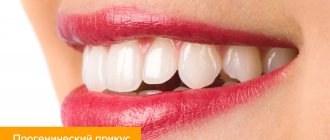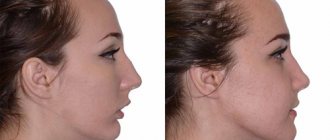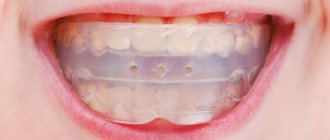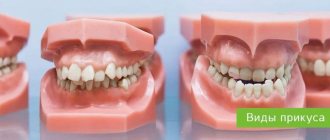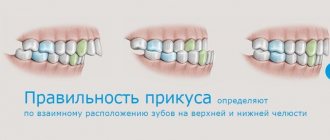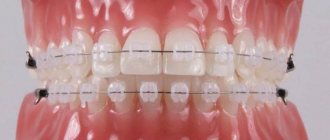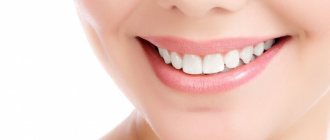Occlusion is the relative position of the teeth relative to each other. In dentistry, this concept is called central occlusion, in which the dentition, when closing the jaws, has the maximum number of points of contact. There are different types of dental occlusion in humans; their types are usually divided into two main groups - correct (physiological) and incorrect (pathological).
The classification of types of occlusion includes several types of correct and incorrect occlusions. Most of them can be determined visually, by functional and morphological characteristics: the structure and symmetry of the dentition, the nature of the closure of the teeth, the usefulness of the function of the dental system. To accurately determine the nature of occlusion in orthodontics, various methods are used; one of the simplest and most effective is measuring the height and type of bite using a face bow, a tool that records the movements of the jaws relative to each other.
Check your bite
There are a number of objective parameters by which the correct, or in other words physiological, bite is determined:
- When closing, the teeth of the upper jaw come into contact with the lower teeth of the same name. The ideal arrangement of teeth is one in which the upper incisors overlap the lower ones by 1/3.
- clear contact of the chewing teeth: molars and premolars,
- no interdental spaces,
- the vertical axis of symmetry of the face passes exactly between the central incisors,
- no problems with diction, chewing and swallowing.
All types of occlusion in dentistry are divided into abnormal and physiological, and within these groups there is a more detailed classification.
Types of correct bite
Let's consider the physiological types of occlusion and their features:
- orthognathic bite - an ideal in which the same 1/3 overlap is observed, which was mentioned above;
- straight - there is no overlap, as in the previous version: the upper and lower incisors are in contact with the cutting edges. This increases the risk of tooth wear, but from the point of view of orthodontics, this case refers to the types of correct bite;
- biprognathic - all incisors are slightly inclined towards the lips, the dentition is pushed forward, but there are no occlusion disorders;
- progenic – the lower jaw is slightly protruded. The closure is tight.
These types of dentition bites do not affect either aesthetics or functionality and are therefore considered the norm.
Incorrect or abnormal bite
The bite is considered incorrect when there are anomalies in the location of the teeth and occlusion disorders, as a result of which the functions of the dentofacial system are disrupted. All types of malocclusion, to a greater or lesser extent, lead to the destruction and loss of teeth, disorders of the TMJ (temporomandibular joint), as well as facial asymmetry. The consequences of an abnormal bite are discussed in more detail below. Orthodontic treatment in this case is necessary not so much for aesthetics, but for maintaining health.
Causes of pathological bite
Factors that provoke improper closure of teeth can be divided into congenital and acquired.
Congenital malocclusion is caused by a genetic mutation, hereditary predisposition or pathology of intrauterine development of the fetus. Such anomalies are more difficult to correct and are often an indication for surgical intervention.
Acquired factors can manifest their effects both in infancy and in adulthood. Thus, the main reasons for the development of malocclusion starting from early childhood are:
- birth trauma of the skull;
- improper latching on the breast when feeding;
- long-term breastfeeding or bottle feeding;
- chronic diseases of the endocrine and respiratory systems;
- lack of essential microelements in the diet, unbalanced nutrition;
- previous rickets;
- bad habits – finger or foreign objects (pencil) in the mouth;
- early tooth extraction, jaw injuries.
With age, factors such as errors in prosthetics, gum disease, the absence of most teeth, and pathologies of the motor joint of the jaw are added.
Types of malocclusion
The following types of malocclusion in adults are distinguished:
- distal bite
– the upper jaw protrudes forward. The upper incisors can be inclined forward, towards the lips, or backward, into the oral cavity. Often there is no contact between the front teeth of the upper and lower jaws, a sagittal gap and disocclusion (lack of closure) are formed. This type of dental malocclusion is visually manifested in a beveled profile and an upper lip hanging over the lower lip; a “double chin” may form;
- mesial bite
– the lower jaw protrudes forward. Here, a sagittal gap may also be observed and there may be no occlusion, or there may be only a slight overlap of the upper teeth with the lower ones. External signs of mesial occlusion are a protruding lower jaw and a massive chin; the lower lip is usually enlarged;
- deep bite
– the lower incisors are hidden by the upper ones by 50% or more. Depending on the stage, with a deep bite in adults, occlusion may be completely absent and inflammation of the tissues of the upper palate may develop due to injury to the lower teeth. With a deep bite, the so-called gummy smile is common, the lower third of the face looks inharmoniously small, and the chin is sloping;
- open bite
– when the jaws close, there is no contact between the upper and lower teeth. This type of bite causes significant impairment of chewing and speech functions; the facial muscles are usually overstrained and the lower part of the face is elongated;
- crossbite
– vertical asymmetry of the jaws; When closing, an intersection of the dentition is observed. It develops when one of the jaws is underdeveloped and leads to noticeable asymmetry of the face.
The above types of dental malocclusions can be supplemented with dystopia - a malocclusion in which one or more teeth are positioned incorrectly, out of place.
Correction methods
Modern orthodontics offers a wide arsenal of instruments, accessories and treatment techniques that can eliminate occlusion disorders.
- Orthodontic plate. A removable device for straightening teeth, consisting of a plastic base that fits tightly to the palate or gum, and metal clamps that gradually shift the tooth into the desired position.
- Braces. Fixed structures that are considered effective for correcting almost all types of malocclusion. Braces can be made of metal, ceramic or plastic.
- Trainers. These are removable dental splints made of silicone or polyurethane. Correcting the position of teeth with trainers includes three stages: preparatory, main and consolidating, each stage takes about six months.
- Aligners. Transparent removable orthodontic structures made of hypoallergenic plastics, in many cases capable of replacing fashionable braces. Aligners are made individually, based on impressions of the patient’s teeth or the results of a digital scan of the jaw.
Orthodontic devices for bite correction
In exceptional cases, in the presence of serious occlusion disorders that have developed due to congenital pathologies of the structure of the skull bones or after jaw deformation as a result of trauma, when it is clear that non-invasive methods for correcting occlusion anomalies will not be effective, surgical intervention is indicated.
Consequences of malocclusion
All types of malocclusion cause a complex of problems, both dental and more general:
- the development of caries and gingivitis is caused by ineffective oral hygiene. Even with regular and thorough brushing of teeth, due to malocclusion, hard-to-reach areas remain where food debris accumulates and bacteria multiply;
- accelerated tooth decay, abrasion and chipping of enamel - caused by uneven load on the teeth;
- disorders of the gastrointestinal tract that occur due to insufficient chewing of food;
- diseases of the respiratory system due to improper development of the dental system;
- problems with the TMJ, causing pain in the head, ears, back, overstrain of the facial muscles, bruxism, poor posture, etc.;
- violations of facial aesthetics: asymmetry, nasolabial folds, sagging skin of the chin and neck - these and other defects caused by malocclusion can be effectively corrected only with the coordinated work of a cosmetologist and an orthodontist.
Need some advice?
Enter your phone number and we will give you a free consultation
I want a consultation
*By making an appointment you consent to the processing of your data
Bite formation in children
The formation of the bite occurs from birth until adolescence. It is possible to identify the type of bite after replacing all baby teeth with permanent ones , however, the dentist may notice an incorrect bite even at the stage of its formation.
The determining factors in the pathological development of the dental system are heredity and habits.
To form a normal bite in a child, the following conditions must be met:
- The development of tooth buds begins in the prenatal period, so during pregnancy a woman must monitor her metabolism and balance her diet so that the body receives a sufficient amount of micro and macroelements. If necessary, the doctor will prescribe the use of synthesized vitamins.
- Bottle-feeding can cause lip pursing and disrupt the natural swallowing reflex pattern. This may prevent the teeth from closing properly. Pacifiers and bottles should be used as little as possible. If this is not possible, you need to purchase an orthodontic pacifier. Dentists consider breastfeeding to be the basis for proper development and closure of teeth.
- A child over two years old should be weaned as quickly as possible from sucking fingers and toys, as this also leads to malocclusion.
- The child should develop the habit of sleeping in a comfortable but correct position: without throwing his head back. Breathing should be even, calm, through the nose, with the mouth closed. Timely treatment of inflammatory diseases of the respiratory system and their prevention are very important.
- It is necessary to pay due attention to the quality of the child’s nutrition and compliance of the diet with age standards.
A lack of minerals and the prevalence of soft, homogenized foods that are not age-appropriate increase the risk of developing malocclusions.
- From the age of two, it is time to begin developing oral hygiene skills.
- Correct posture should be developed in the child. Few parents pay attention to the spine in the context of bite formation, but each type of dental bite in a person is directly related to the characteristic position of the spine and head.
Photo: correct and incorrect bite of teeth
A systematic visit to a pediatric orthodontist ensures timely identification of problems in the development of the dentofacial apparatus. The doctor will be able to explain which bite is considered correct for a particular age category, identify pathology at the initial stage, give preventive advice and prescribe the correct treatment. If the child has the first symptoms of malocclusion, the doctor will prescribe formative gymnastics and corrective massage or advise installing trainers and a vestibular plate.
It is easier and faster to prevent problems with occlusion than to correct existing defects in the dental system. But even in adults, the risk of abnormal bite formation remains. The reasons for this may be:
- maxillofacial injuries;
- gum disease;
- gross mistakes by the doctor during prosthetics;
- loss of teeth.
Types of bite correction
Orthodontic and surgical types of bite correction depend on the nature of the pathology. In case of skeletal abnormalities, surgical intervention is necessary to correct the bite. In other cases, with dental anomalies, only orthodontic treatment is sufficient. In our clinic, we use aligners for this - invisible mouth guards that allow you to correct all types of dental bites in a person of any age. The technology allows you to achieve a guaranteed result within a predetermined period, and even before the start of treatment you will see what your smile will look like after the bite is corrected.
Causes of occlusion violation
A person’s dental bite is formed by the age of 16-17 years. The main cause of occlusal anomalies is disturbances in the development of the jaws. In this case, wide interdental spaces may form between the central incisors (diastema) or other teeth (trema), or, on the contrary, crowding of teeth may occur. Due to lack of space, individual teeth may be located outside the dental arch (dystopia), rotated around an axis (rotation), or overlap each other. A lack of space between adjacent teeth of 2-3 mm is considered a mild degree of crowding, 7 mm or more is diagnosed as a severe degree of pathology.
Malocclusion can also be caused by:
- long-term use of a pacifier;
- the child's habit of thumb sucking;
- chronic ENT diseases, due to which the child breathes through the mouth most of the time;
- late teething;
- edentia (congenital absence of one or more teeth).
- diseases of the central nervous system (epilepsy, cerebral palsy);
- prolonged inflammatory processes in the area of the jaw joints.
Violations of occlusion often lead to inflammation of the gums, rapid abrasion of tooth enamel and the development of carious processes. If there is poor contact between the teeth, food is not chewed enough, which provokes the development of gastrointestinal diseases. Therefore, correcting malocclusion is important not so much for aesthetic reasons as for maintaining health.
The influence of malocclusion on appearance

